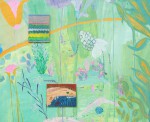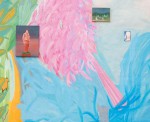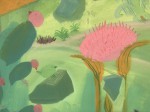Droomland
Marie Zolamian
At Jester (Genk, 2022), I presented an exhibition of small- and medium-format studio paintings. The space, a protected C-mine building, did not allow nails in the walls. For three weeks I painted a 3.10 × 13.45 m canvas on site, « Symbiocene », which became the support for the studio paintings and ceramics.
To prepare the exhibition, I spent several days in April 2022 at the Emile Van Doren Museum in Genk. Emile Van Doren, a local landscape painter, worked within the « Station d’artistes » colony alongside fellow painters and scientists who came to study the region’s rich biodiversity.
As the museum notes, « between 1840 and 1940 more than 450 landscape painters visited Genk. »
Meanwhile in our landscape, fire erases, water swallows, and the disappearance of living species (other than humans) is no longer 5% or 10% but 70%, 80%, 90%, 100%. The subject of landscape no longer felt outdated but inevitable; it imposed itself on me.
I turned to the concepts of Australian environmental philosopher Glenn Albrecht and his « Earth Emotions ». He addresses collapse, yet introduces new concepts for another possible world.
While painting, I listened extensively to Albrecht. Hence the title of the large canvas, « Symbiocene » (as opposed to the Anthropocene: the Symbiocene imagines cohabitation without human domination), and « Solastalgia » for the painting with the flying carpet. The exhibition itself is titled « Droomland », borrowed from a 1930s poster advertising the city of Genk, from a time when mine workers could not see daylight.
The format of « Symbiocene »—a longitudinal framed landscape—emerged from my memories of Beirut: large wall carpets covered with photographs, talismans, « gris-gris », artefacts and everyday objects, like unrolled cabinets of curiosity common in many Eastern homes. A moving visual walk with multiple perspectives, where getting lost becomes a source of discovery.
I painted a kingdom inhabited exclusively by birds, deliberately excluding humans to see what would emerge. When I began the 3.10 × 13.45 m painting, this was my only initial constraint; everything else unfolded over the three weeks of working on site.
A scene of birds and vegetation appears through the play of colour, transparencies, pentimenti, accidents and clashes. Human figures are absent—except in a zone of dawn or dusk, where they lean in, observing, trying to understand, to protect what they see. As with the protection of man-made heritage, it is said that by observing and understanding, we can better protect what is observed.
The superpositions, juxtapositions, confrontations, associations and camouflages of the studio paintings form a kind of scrambled nesting structure. Fragments of paintings move together, endlessly recomposing themselves.
The large painting, together with the smaller paintings and ceramics, functions as a single, modular work that also stands alone. It opened up a new pictorial space, an externalised field of play that could still astonish and surprise me.
The whole is a giant miniature: a dense field of influences, meticulous and looser details, perspectives, interlacings, repetitions, geometries and colours that confront one another. A confrontation between minor and major art. Dead ends and twists. Seen up close, the scale opens and dilates into a vast terrain. It reads like a map through which the story is told by disparate elements.








